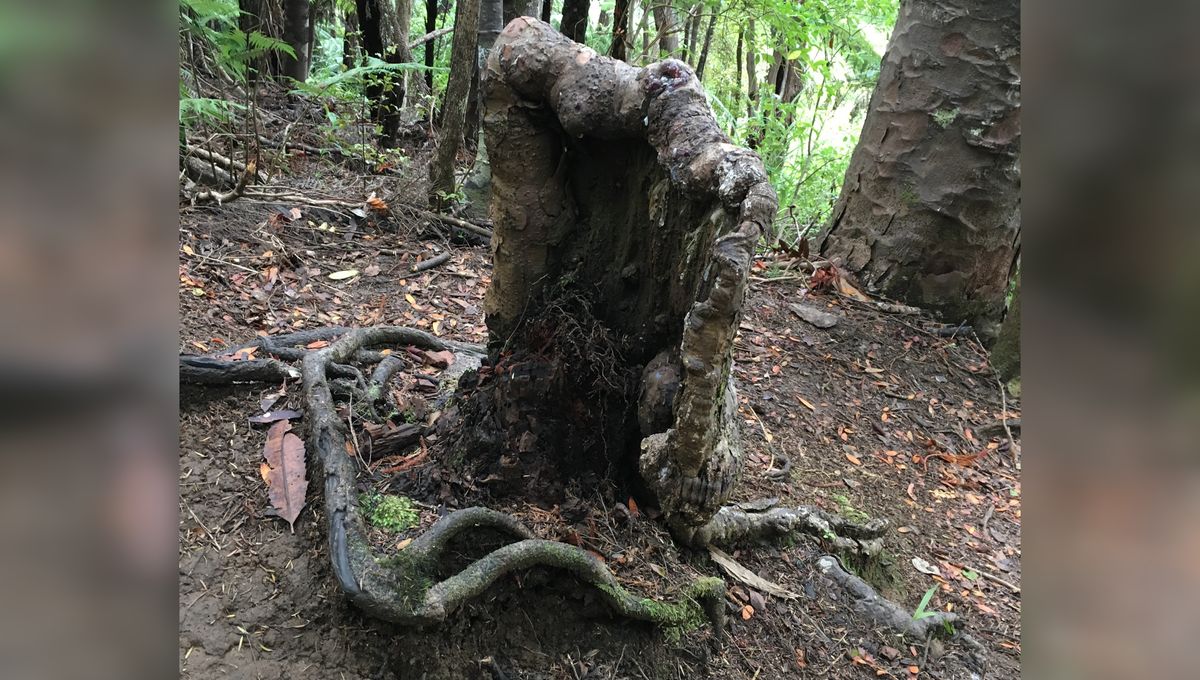
Nature is often portrayed as a brutal dog-eat-dog world where only the fittest individuals are permitted to survive and thrive. Deep in the forests of New Zealand, however, there is a tree stump that shows it isn’t always that straightforward.
This stump of a kauri tree should have died long ago as it has lost its green leaves needed for photosynthesis. Nevertheless, it is being kept alive with the help of its neighboring trees. The nearby trees have grafted their root systems to that of the dying stump, pumping it with water and nutrients like a life-support system.
Back in 2019, a team of scientists came across this curious specimen while hiking around the Waitākere Ranges in West Auckland.
“It was odd, because even though the stump didn’t have any foliage, it was alive,” Sebastian Leuzinger, corresponding author and associate professor at the Auckland University of Technology, said in a statement.
Stumped by the discovery, they decided to carry out an experiment on the undead tree. The stump and some of the neighboring trees were hooked up to several sensors that tracked the flow of water and sap, as well as the release of carbon dioxide.
As reported in the journal iScience, the findings suggested that the roots of the stump and the neighboring trees were grafted together, allowing the stump to receive the water and nutrients it needed to survive.
“This is different from how normal trees operate, where the water flow is driven by the water potential of the atmosphere. In this case, the stump has to follow what the rest of the trees do, because since it lacks transpiring leaves, it escapes the atmospheric pull,” Leuzinger explained.
The question is why the surrounding trees embarked on the costly endeavor to prop up their dying neighbor. Kind-hearted altruism? Loyalty?
The relationship is especially costly for the healthy trees because the connectivity can allow diseases to spread more rapidly. This is particularly relevant for the kauri, which is considered to be vulnerable to extinction in its homeland due to the spread of kauri dieback disease caused by the pathogen Phytophthora agathidicida.
“For the stump, the advantages are obvious – it would be dead without the grafts, because it doesn’t have any green tissue of its own,” Leuzinger said. “But why would the green trees keep their grandpa tree alive on the forest floor while it doesn’t seem to provide anything for its host trees?”
One idea is that the trees were always grafted together in this interlinked mesh to help share water and nutrients during times of drought in a “you scratch my back and I’ll scratch yours” set-up. The leafless stump would have stopped producing carbohydrates, but it likely went unnoticed and continued to ride on the backs of surrounding trees
To better understand this fascinating relationship, the researchers believe we need to see the forest ecosystems as vast “superorganisms”. This research focuses on just a single tree, but it is evident that many forest ecosystems appear to function like interconnected communal superorganisms, not simply competing individual organisms.
“This has far-reaching consequences for our perception of trees – possibly we are not really dealing with trees as individuals, but with the forest as a superorganism,” Leuzinger added.
“This is a call for more research in this area, particularly in a changing climate and a risk of more frequent and more severe droughts,” Leuzinger says. “This changes the way we look at the survival of trees and the ecology of forests.”
Source Link: This Undead Kauri Tree Doesn't Abide By "Survival Of The Fittest"